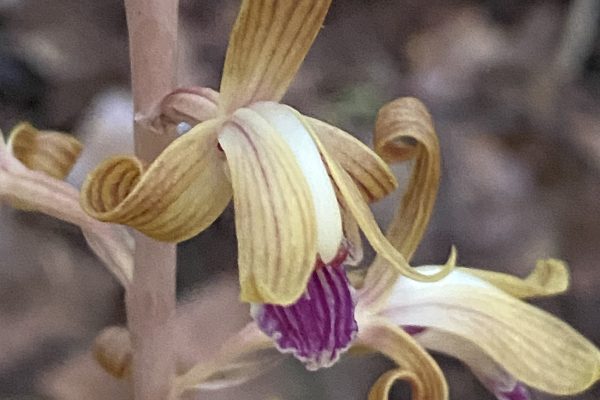Searching for the crested coralroot

Less than 70 miles. That’s the distance between my home in Charlotte and our place in the Uwharries. Sometimes the two feel worlds apart. Blue city, red county. Skyscrapers, silos. Congested streets, open roads. High-rise condos, low-slung ranch houses. It sometimes seems they have nothing in common. And then a rare occurrence reminds us just how much we share.
On the first Uwharrie Trail thru-hike, way back in July 2013, the Landtrust’s Crystal Cockman spotted an unusual orchid on King Mountain. “I almost threw my backpack down on it,” she said recently. “I think I screamed when I saw it.”
She knew she had found a gem. While the crested coralroot (Hexalectris spicata) occurs in 35 counties across the state, don’t be fooled by its wide distribution – nowhere is it common. In fact, the N.C. Natural Heritage Program (NCNHP) lists it as significantly rare and imperiled.
Crested coralroot blooms in mid-summer, a time when many lay naturalists avoid tromping around off-trail, especially in the Uwharries, given the region’s healthy population of timber rattlers. Like a camouflaged snake, the crested coralroot can be hard to see against the forest floor in dappled light. At a distance, the 12-18” pinkish-brown stems can resemble dead twigs. Ten or more small flowers are scattered around the top portion of the stem – striped in subtle, earthy shades of maroon, cream and gold. A vivid purple lip is their only nod to extravagance. Noted orchid photographer Jim Fowler, who passed away suddenly in late June, considered the crested coralroot “one of North America’s most beautiful orchid species.”
[Read this 2019 blog post to experience his delight in observing this species at Stone Mountain State Park.]
As for the ones on King Mountain, Crystal has never seen them again. Nor has she ever managed to find a reported occurrence near Morrow Mountain, despite multiple visits, one of which resulted in a bad case of seed ticks. Some sources suggest that crested coralroot might not bloom every year in some locations. Even when they do appear in the landscape, they’re present for only two to three months. Their fleeting nature is explained by a lack of chlorophyll – they have no need for showy leaves. They obtain nutrients through a symbiotic relationship with mycorrhizal fungi in the soil.
In mid-July, Crystal and a friend decided to hike the Uwharrie Trail from the Moffitt trailhead to Poison Fork. Near the top of Little Long Mountain, not far off the trail, a clump of stems caught her attention. The flowers were past their glorious peak, but she knew immediately she had stumbled upon another occurrence of crested coralroot in the Uwharries. As Stan Bentley notes in Native Orchids of the Southern Appalachian Mountains, they have a penchant for inaccessible places – cliffsides, steep ridges and mountain tops. This species’ habitat preference is enigmatic, if not downright contradictory. They seem to favor a basic oak-hickory forest, but they can also be found in acidic, loamy soils in the Sandhills and in rich forests over marl in the lower coastal plain.
And sometimes they appear in the most unlikely location of all – a backyard in Charlotte. In early August, my sister, Amy, was wandering through the patch of mature hardwoods behind her house, not something she often does in mid-summer. Over the years, as she removed invasive species like English ivy and ligustrum, the native understory flourished. Redbuds and pawpaws had encroached on her path. As she searched for the best route through the dense, green vegetation, something very different caught her eye. The stems and flowers glowed, backlit by a late-day sun. She knew she’d found some sort of orchid.
My first guess was a crane-fly orchid – they also bloom this time of year and are fairly common in the Piedmont’s hardwood forests – but the flowers were clearly too fancy. Amy poked around online and narrowed it down to a couple potential species, with crested coralroot as the top contender. I advised her to consult the Uwharries’ native orchid guru. Crystal responded quickly and enthusiastically, confirming her identification. She also encouraged Amy to report this rare occurrence to the NCNHP.
The three of us were gobsmacked. What are the odds of stumbling across two previously unknown occurrences of such a rare species in such radically different locations? After reflecting on it, I believe I’ve found a common denominator – two amazing women who hail from the Uwharries. They share the important traits that make this sort of discovery possible – they take time, pay attention, and allow themselves to be open to the wonders of the natural world. They also happen to enjoy the charms of a Piedmont forest, even in mid-summer.